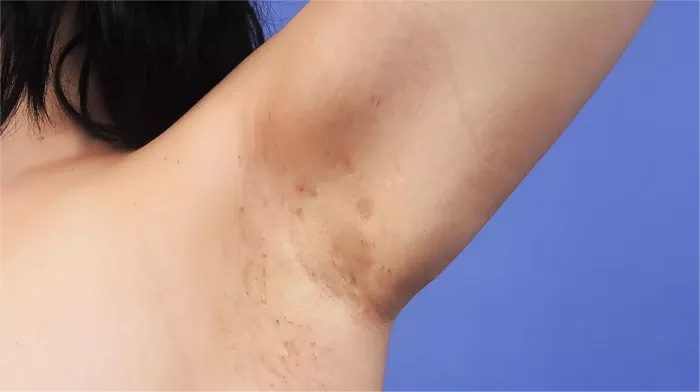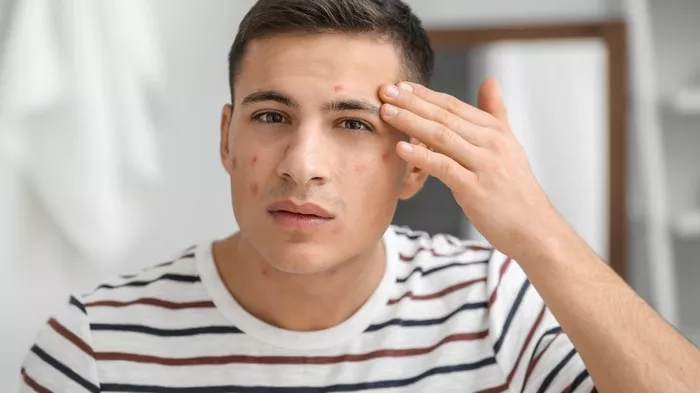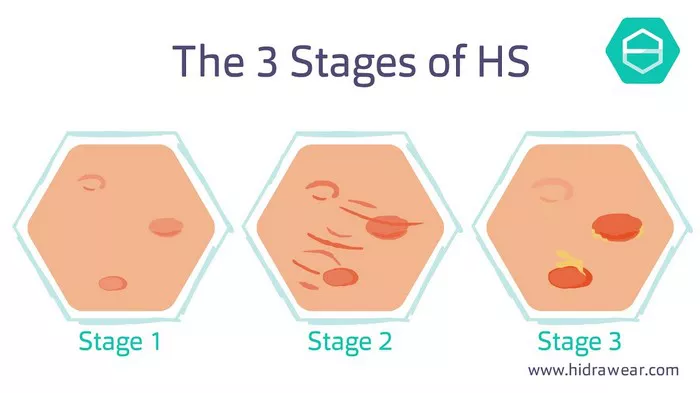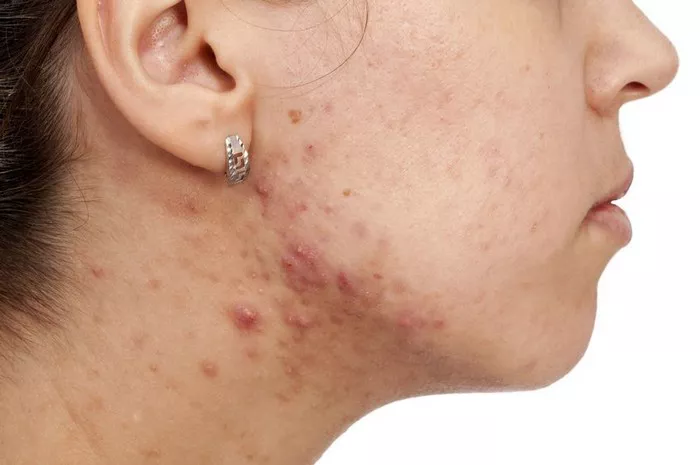Hidradenitis Suppurativa (HS), also known as acne inversa, is a chronic skin condition characterized by painful, boil-like lumps that form under the skin. These lumps, also referred to as abscesses or boils, can rupture and release foul-smelling pus. HS typically affects areas of the body where skin rubs together, such as the armpits, groin, buttocks, and under the breasts. The exact cause of HS is not fully understood, but it is believed to be related to inflammation of the hair follicles and sweat glands.
Symptoms of Hidradenitis Suppurativa
The primary symptom of HS is the development of painful, inflamed nodules or boils. These can vary in size from a pea to a golf ball and often occur in clusters. The nodules can rupture, leading to the formation of tunnels or sinus tracts under the skin. These tracts can cause chronic drainage and scarring. Other symptoms of HS include:
- Blackheads: Small, pitted areas of skin containing blackheads, often appearing in pairs.
- Red, tender bumps: These can enlarge, break open, and drain pus, which may have an unpleasant odor.
- Painful lumps: These can form under the skin and persist for years.
- Tunnels: Over time, tunnels connecting lumps may form under the skin. These can drain pus and cause significant scarring.
Causes and Risk Factors
The exact cause of HS is unknown, but several factors may contribute to its development, including:
Genetic Factors
There is evidence that genetics play a role in HS. The condition tends to run in families, and certain genetic mutations have been linked to HS.
Hormonal Changes
Hormonal changes, particularly those related to menstruation, can trigger or worsen HS. The condition often begins after puberty and may improve after menopause.
Obesity
Being overweight can exacerbate HS symptoms. Excess weight increases skin friction and sweating, which can contribute to inflammation and the formation of boils.
Smoking
Smoking is a known risk factor for HS. It is believed that smoking can trigger immune system responses that lead to inflammation of the hair follicles.
Immune System Dysfunction
HS is considered an autoinflammatory condition, meaning that the body’s immune system mistakenly attacks healthy tissue. This immune response causes inflammation and the formation of boils.
Stages of Hidradenitis Suppurativa
HS is classified into three stages, known as Hurley stages, based on the severity and extent of the condition:
Stage 1: Mild
- Single or multiple abscesses without sinus tracts or scarring.
- Painful nodules that may resolve without treatment.
Stage 2: Moderate
- Recurrent abscesses with sinus tracts and scarring.
- Abscesses separated by normal skin.
Stage 3: Severe
- Diffuse or near-diffuse involvement with multiple interconnected sinus tracts and abscesses.
- Significant scarring and chronic drainage.
Diagnosis of Hidradenitis Suppurativa
Diagnosing HS can be challenging, as it is often mistaken for other skin conditions such as acne, folliculitis, or boils. A thorough medical history and physical examination are essential for an accurate diagnosis. Key aspects of the diagnosis include:
- Clinical Examination: A dermatologist will examine the affected areas and look for characteristic signs of HS, such as nodules, sinus tracts, and scarring.
- Patient History: The doctor will ask about the patient’s symptoms, family history, and any factors that may trigger or worsen the condition, such as hormonal changes or smoking.
- Biopsy: In some cases, a skin biopsy may be performed to rule out other conditions and confirm the diagnosis.
Treatment Options
There is no cure for HS, but various treatment options can help manage symptoms, reduce flare-ups, and improve the quality of life. Treatment plans are tailored to the individual and may include:
Medications
- Topical Antibiotics: Clindamycin or other topical antibiotics can be applied to the affected areas to reduce inflammation and bacterial growth.
- Oral Antibiotics: Long-term use of oral antibiotics, such as tetracycline, doxycycline, or minocycline, can help control infection and inflammation.
- Biologics: Adalimumab (Humira) is an FDA-approved biologic for HS that targets specific parts of the immune system to reduce inflammation.
- Hormonal Therapy: For women, hormonal therapy such as oral contraceptives or anti-androgen medications (e.g., spironolactone) can help regulate hormonal fluctuations that may trigger HS.
- Immunosuppressants: Drugs like cyclosporine may be prescribed to suppress the immune system and reduce inflammation.
SEE ALSO: The Best Natural Treatment for Hidradenitis Suppurativa
Surgical Interventions
- Incision and Drainage: For painful abscesses, a minor surgical procedure can be performed to drain pus and relieve pain. However, this is usually a temporary solution.
- Laser Therapy: Laser treatments can help reduce the number of nodules and sinus tracts by targeting hair follicles.
- Excision: In severe cases, surgical removal of the affected skin and tissue may be necessary. Skin grafts or flaps may be used to cover the area.
- Carbon Dioxide Laser Surgery: This method involves using a carbon dioxide laser to remove affected tissue and reduce scarring.
Lifestyle Modifications
- Weight Management: Maintaining a healthy weight can help reduce skin friction and sweating, which may alleviate symptoms.
- Smoking Cessation: Quitting smoking can improve overall health and may reduce the severity of HS symptoms.
- Hygiene: Keeping the affected areas clean and dry can help prevent infections and reduce irritation. Using antibacterial soaps or cleansers may be beneficial.
- Clothing: Wearing loose-fitting, breathable clothing can minimize skin friction and irritation.
Living with Hidradenitis Suppurativa
HS can have a significant impact on a person’s physical and emotional well-being. Chronic pain, scarring, and drainage can affect daily activities and self-esteem. It is essential for individuals with HS to work closely with their healthcare providers to develop a comprehensive treatment plan. Support groups and counseling may also be beneficial for managing the emotional aspects of the condition.
Coping Strategies
- Pain Management: Over-the-counter pain relievers, such as ibuprofen or acetaminophen, can help manage mild pain. For more severe pain, prescription medications may be necessary.
- Stress Management: Stress can exacerbate HS symptoms, so finding ways to manage stress, such as through exercise, meditation, or therapy, is important.
- Healthy Diet: A balanced diet rich in anti-inflammatory foods, such as fruits, vegetables, and omega-3 fatty acids, may help reduce inflammation and improve overall health.
- Skincare Routine: Developing a gentle skincare routine that avoids harsh chemicals and fragrances can help prevent irritation.
Research and Future Directions
Ongoing research is focused on better understanding the underlying mechanisms of HS and developing more effective treatments. Some areas of interest include:
- Genetic Studies: Identifying genetic mutations associated with HS may lead to targeted therapies and personalized treatment plans.
- Immune System Research: Understanding how the immune system contributes to HS can help identify new therapeutic targets.
- Clinical Trials: New medications and treatment approaches are being tested in clinical trials to determine their safety and effectiveness for HS.
Conclusion
Hidradenitis Suppurativa is a chronic skin condition that causes painful, boil-like lumps to form under the skin. While there is no cure, various treatment options can help manage symptoms and improve the quality of life. Early diagnosis and a comprehensive treatment plan are essential for effectively managing HS. Individuals with HS should work closely with their healthcare providers to find the best treatment strategies and seek support for the emotional challenges associated with the condition. With ongoing research and advancements in treatment, there is hope for better management and improved outcomes for those living with HS.
Related Topics:
























